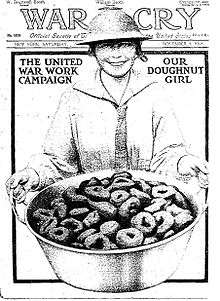National Doughnut Day

National Doughnut Day, or National Donut Day - celebrated in the United States, is on the first Friday of June of each year, succeeding the Doughnut Day event created by The Salvation Army in Chicago in 1938 to honor those of their members who served doughnuts to soldiers during World War I.[1] The holiday celebrates the doughnut (a.k.a. donut) – an edible, torus-shaped piece of dough which is deep-fried and sweetened. Many American doughnut stores offer free doughnuts on National Doughnut Day.[2][3][4][5]
History
National Doughnut Day started in 1938[1] as a fund raiser for Chicago's The Salvation Army. Their goal was to help those in need during the Great Depression, and to honor The Salvation Army "Lassies" of World War I, who served doughnuts to soldiers.
Soon after the US entrance into World War I in 1917, The Salvation Army sent a fact-finding mission to France. The mission concluded that the needs of US enlisted men could be met by canteens/social centers termed "huts" that could serve baked goods, provide writing supplies and stamps, and provide a clothes-mending service. Typically, six staff members per hut would include four female volunteers who could "mother" the boys. These huts were established by The Salvation Army in the United States near army training centers.
About 250 Salvation Army volunteers went to France. Because of the difficulties of providing freshly baked goods from huts established in abandoned buildings near to the front lines, the two Salvation Army volunteers (Ensign Margaret Sheldon and Adjutant Helen Purviance) came up with the idea of providing doughnuts. These are reported to have been an "instant hit", and "soon many soldiers were visiting The Salvation Army huts". Margaret Sheldon wrote of one busy day: "Today I made 22 pies, 300 doughnuts, 700 cups of coffee."
Soon, the women who did this work became known by the servicemen as "Doughnut Girls".[6]

A misconception has taken hold that the provision of doughnuts to US enlisted men in World War I is the origin of the term "doughboy" to describe US infantry. But, the term was in use as early as the Mexican-American War of 1846–47.
In Chicago, National Doughnut Day is still a fundraiser for The Salvation Army.
In the Second World War, Red Cross Volunteers also distributed doughnuts, and it became routine to refer to the Red Cross girls as Doughnut Dollies as well.
There are three other doughnut holidays, the origins of which are obscure. International Jelly-Filled Doughnut Day is widely recognized as June 8 (occasionally as June 9). National Cream-Filled Doughnut Day is celebrated on September 14. Buy a Doughnut Day occurs on October 30.
The birthday of the United States Marine Corps was once referred to as National Donut Day, in a successful ruse by American prisoners of war at Son Tay prison camp to trick the North Vietnamese into giving out donuts in honor of the occasion.[7]
See also
- List of food days
- List of doughnut varieties
 Food portal
Food portal
Notes and references
- 1 2 Kevin Fagan A holey holiday – National Donut Day February 31, 2009 SF Chronicle
- ↑ "LaMar's Donuts Celebrates National Donut Day With Free Donut". LaMar's Donuts & Coffee shop. Retrieved May 29, 2011.
- ↑ Elina Shatkin (June 2, 2009). "Small Bits: Test Kitchen Tuesdays at Corkbar and National Donut Day". Los Angeles Times. Retrieved June 4, 2009.
- ↑ Chris Reidy, Globe staff (June 4, 2009). "Dunkin': Buy joe, get free Donut Day sinker". The Boston Globe. Retrieved June 4, 2009.
- ↑ Lorraine Eaton (June 4, 2009). "Krispy Kreme Donuts – Free tomorrow!". The Virginian-Pilot: HamptonRoads.com. Retrieved June 4, 2009.
- ↑ Susan Mitchem, Director of the Archives at Salvation Army Headquarters. "Doughboy Center - The Story of the American Expeditionary Forces".
- ↑ "Today is National Donut Day: A funny POW story". November 10, 2009. US Naval Institute. Retrieved November 9, 2012.
Sources
- Those Extraordinary Women of World War I, Karen Zeinert, 2001
- Origins of "Doughboy", An Interim Report, by Michael E. Hanlon, June 16, 2003
- Holiday Insights : National Doughnut Day, or National Donut Day